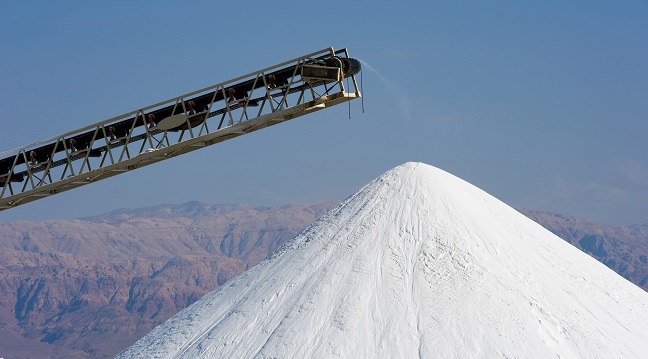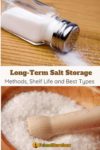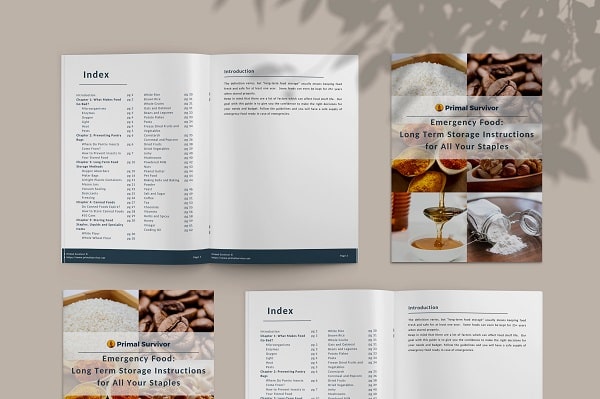In one of my favorite survival movies, the hero is stranded on an island. He eventually learns to trap animals to eat but is desperate for flavor. He has an epiphany when some sweat gets into his mouth: “I taste so good!” he exclaims. After that, he carries around a little bottle to gather his sweat to flavor his food.
Hopefully, none of us end up having to use sweat as a salt alternative in an emergency scenario. Luckily, long-term salt storage is very easy.
How, Why, and When To Store Salt: The Short Answer
- Store approximately 10lbs of salt per person for a year’s supply.
- This should meet salt needs for food/nutrition and other uses.
- Choose pure salt without iodine or additives because it has the best shelf life and can be used in many ways.
- Put salt in sealed bags to protect it from moisture, and put those into buckets to protect against physical damage.
Why Store Salt
Before globalization, salt was a valuable commodity. Roman soldiers got paid in salt (hence the phrase “worth their salt”). Wars have been fought over salt throughout history, and revolutions started because of salt.
So why is salt so important? Here are some key reasons you should have a stockpile of salt on hand. (1)
Nutrition
Most commercial food has so much added salt that we forget how essential it is. Salt contains sodium, which our body needs to transmit nerve impulses, contract and relax muscle fibers, and maintain fluid balance. If we didn’t get enough sodium, our hearts would stop beating.
Meat does have a lot of natural sodium in it. However, plant foods don’t have as much sodium. You’d have to eat about 47 stalks of celery (a high-sodium vegetable) per day to get enough sodium.
Food Preservation
Salt is also precious because it can be used for preserving food. You can read more about that in this post about DIY Lacto fermentation instructions and salt-curing meat.
Medicine
Because salt draws moisture out of cells, it can kill many bacteria and fungi cells. Thus, salt is an excellent natural remedy for oral thrush and throat infections. It’s also used to make a saline solution for cleaning wounds, sinuses, and eyes.
Cheap Bartering Item
If a large-scale disaster were to hit, you could use salt to trade for other items you need. Because salt is so cheap and easy to afford, it is one of the best bartering items to stockpile
How Much Salt to Store

The Institute of Medicine recommends that healthy adults consume at least 1,500mg (1.5g) of sodium but no more than 2,300mg (2.3g) per day. (4) An ounce of pure salt contains approximately 10,990mg of sodium.
Based on these numbers, a healthy adult needs 50-76oz (3.125-4.75lbs) of salt per year for nutrition.
However, salt has many other uses than just seasoning food. If you want to use salt for food preservation, natural remedies, or bartering, you should stockpile much more salt than this.
When you factor in the other uses for salt, you likely need around 10lbs of salt per person per year.
Does Salt Go Bad?
Salt does not go bad and can last forever. However, many types of salt we buy contain additives like iodine or anti-clumping agents. Over time, these can degrade. The salt will still be good to eat but may lose its iodine or develop an off-color.
Salt can also get wet, turn into a rock-hard clump, or pick up odors from the surrounding environment. Even then, the salt is not “bad” and is still safe to consume.
Drying Out Wet Salt
If your salt stockpile gets wet from high humidity, you can dry it out. Spread it on a baking tray and put it in the oven at a low temperature. Stir occasionally to break up any clumps. Ensure the temperature stays below 200F because the salt might discolor at temperatures higher than this.
Breaking Up Salt Clumps
If you don’t store salt in a completely air-tight container, it can absorb moisture from the air and start to form hard clumps. Small clumps can be broken up in a high-speed blender.
Larger, harder clumps will have to be broken up by hand. Get out a (clean) hammer and start banging it into pieces. Once you get the salt into smaller pieces, you can put the salt in a metal colander with something underneath. Push on the clumps with a bowl or spoon. As the salt breaks apart, the crystals will fall through the colander.
Best Type of Salt for Long Term Storage
Pickling salt, canning salt, or kosher salt without iodine or additives are the best types of salt for long-term storage because they won’t go bad. Their purity also means they can be used in multiple ways. Sea salt is also a good choice but tends to be more expensive.
Below is an overview of the various types of salt and why you might want to stockpile them.
Table Salt & Iodized Salt
The most common type of salts are table salt and iodized salt. These usually contain 97-99% sodium chloride with some anti-caking agents. Iodized salt has iodine in addition to the anti-caking agents.
Iodine is an essential nutrient that might be difficult to get on an emergency food diet. However, using non-iodized salt for things like DIY pickling and salt-water sinus rinses is better.
Over time, the iodine can turn the salt yellowish. It’s still safe to eat, but it might make the salt less valuable as a bartering item. If you are worried about getting enough iodine, consider stockpiling seaweed or a supplement.
- Contains: Iodine, anti-clumping agents
- Use for: Cooking
- Shelf Life: Around 5 years
Kosher Salt
Kosher salt is made up of large crystals of salt. Traditionally, kosher salt does not contain any iodine or additives. However, some brands of kosher salt do have additives, so you have to read the label.
Because it is pure, kosher salt is good for everything from cooking to preserving food.
The only real drawback is that the large crystals don’t dissolve as easily, which isn’t ideal for baking. Larger crystals also mean that there’s less salt per teaspoon. When following recipes based on table salt, you must adjust the amount of kosher salt (1tsp of table salt usually equals 1 ¼ tsp of coarse kosher salt).
- Contains: Usually just pure salt
- Use for: Cooking, food preservation, medicinally
- Shelf Life: Indefinite
Sea Salt
Sea salt is made by evaporating seawater. Or, in the case of Real Salt from Utah, from an underground salt deposit left by an ancient sea. Depending on the source of the seawater, the resulting salt will contain various natural minerals.
Because of these minerals, sea salt is considered healthier than other salt types. However, it’s worth noting that these minerals are only present in very tiny amounts. You shouldn’t rely on sea salt as a source of nutrition.
Many sea salt brands do add iodine to their products. These salts are not recommended for food preservation or medicinal uses. Like with table salt, iodized sea salt will eventually start to yellow. Non-iodized sea salt will last indefinitely and can be used in many ways.
- Other names: Celtic salt, Fleur De Sel, Sel Gris, flake salt
- Contains: Trace minerals
- Use for: Cooking, food preservation, medicinally
- Shelf Life: Indefinite
Also see: How to get salt from natural sources.
Himalayan Pink Salt
Like sea salt, Himalayan pink salt is generally considered “healthier” because it contains natural minerals. But these minerals are only in trace amounts, so they aren’t going to make a difference to overall health.
Because Himalayan sea salt is so expensive, I wouldn’t recommend it for long-term storage. It makes more sense to stockpile some multivitamins and mineral supplements.
- Contains: Trace minerals
- Use for: Cooking, food preservation, medicinally
- Shelf Life: Indefinite
Canning and Pickling Salt
Canning and pickling salts contain no iodine, anti-caking agents, or other additives. The main feature of these salts is their tiny grain size, which allows them to dissolve faster in liquids. They are refined, so they also don’t have any trace minerals.
- Contains: Trace minerals
- Use for: Cooking, food preservation, medicinally
- Shelf Life: Indefinite
How to Store Salt Long-Term
You must keep salt in a dry place so it doesn’t absorb moisture from the air. You’ll also want to keep it away from strong-smelling items so it doesn’t pick up any odors. If you are storing iodized salt, take care to keep the salt away from heat because heat will degrade iodine.
For disaster prepping, the main thing you need to think about is keeping the salt safe from physical damage. You don’t want a roof beam to smash against your salt and cause it to spill all over, nor do you want nasty flood water to seep into your salt containers.
Below are some of the best methods for storing salt, so it stays good and safe to use for decades.
Air-Tight Plastic Containers
Simply put the salt into an air-tight container. You can keep the salt in its original packaging and put this into the container. Or, to save space, dump the salt from its packaging into the container.
Buckets
Buckets are great for storing large amounts of salt. You can dump salt directly into the bucket, leave it in its original packaging, or repackage it in bags. The great thing about buckets for salt storage is that they are mostly indestructible. A roof beam could fall on your salt bucket, and it might survive.
Unfortunately, though, buckets usually are not entirely waterproof. If you live somewhere prone to flooding, you might need to take extra steps to keep water from getting to your salt stockpile – such as sealing the salt in Mylar bags first.
Alternatively, you can seal around the bucket lid with silicone sealant. However, the seal will be broken when you open the bucket. A simple solution is to use gamma lids instead. Even after sealing around the bucket/lid area, you’ll still be able to open the lid. The O-ring on the gamma lid is very waterproof.
Vacuum Sealing
You can vacuum seal salt to keep moisture out of it. This will help prevent clumping. However, some air will eventually still seep through the bags.
Because vacuum sealer bags aren’t exactly cheap, I wouldn’t bother using them for salt. You can put the salt in double zip bags instead: press as much air out of the bags as you can, close them, roll down the top of the bags, and tape the edges with packing tape.
Mylar Bags
Mylar is a metal-like material that won’t let any air through. Not only does this protect the salt from moisture, but it also keeps it safe against floods.
The bags could be floating around in floodwater, and the salt inside would still be safe to eat. Mylar bags can still be punctured (such as if a roof beam falls on them), so many people take the extra step of putting Mylar bags into buckets.
If you aren’t in a flood zone, it might be overkill to store salt in Mylar bags; regular zip bags will work just as well.
*Note that you should not use oxygen absorbers when storing salt in Mylar bags. Read more about Mylar food storage and oxygen absorbers here.
Mason Jars
Mason jars with two-piece lids provide a very tight seal. Moisture won’t be able to get into the jar, so your salt will stay dry and clump-free. The downside is that Mason jars can break. If you live in areas prone to earthquakes or other natural disasters, it might be better to store salt in plastic buckets.
*Do Not Store Salt in Metal Containers
Never put salt in metal containers for long-term storage. Salt will corrode metal containers, causing rust and chemicals in your salt.
How I Store Salt
I use this method for long-term salt storage:
- Buy bags of salt (not boxes)
- Put the bags of salt into sturdy zip bags
- Close the bags and seal the edge with plastic packing tape
- Put the bags into a bucket with a gamma-seal lid
- Use silicone sealant to waterproof the bucket lid
This method should keep my salt safe through most disasters but is still cheap and easy. If I lived in a hurricane area, though, I would probably use Mylar instead of zip baggies.
How do you store salt long-term? Let us know in the comments.



Can you use moisture absorbers
i`ve heard said not to use oxygen absorbers in salt storage because botulism can happen,, if vac sealed in plastic vac bags is that the same as oxygen absorbers and run a risk?
thank you, toby
If you use OAs with salt, the salt will turn into a rock-hard block. Also, there’s no need to use OAs with salt because salt literally never goes bad. However, it doesn’t cause a risk of botulism.
Botulism can occur if you use OAs with wet foods though. Foods should contain less than 10% moisture to be safely used with OAs. More on that here: https://www.primalsurvivor.net/oxygen-absorbers/
Should you use a desiccant when storing salt in Mylar bags?
You could, but it’s really not necessary. If you live somewhere humid, it’s better to just package your foods on a low-humidity day or have a dehumidifier running for a while before you start packaging.
We store salt directly into food grade 65 gal pickle barrels. 300 lbs and there is still room for more. More than 300 lbs makes it difficult to move. Barrels come with 2 piece gama style lids and a gasket.
Salt and sugar sealed in a vacuum sealer will turn into a solid block. If you seal it in a glass jar you risk breaking the jar.
I have a vacum attachment for mason jars . I am a little concerned about the metal 2 piece lids however.
You can get plastic lids
Thanks for the useful information which I found to be very complete.
The cheapest way I have found to buy food grade salt is to get what we use for swimming pools at places like Wal Mart when they have it on sale. Having a salt water pool I usually but ten 50 lb bags but I will now start to look at long term survival storage as well…Thanks for the information Bob
What about using salt blocks for some long term storage?
That would also work 🙂
Thank you, Very informative. I find for small (vehicle or portable readiness) some of the plastic “ammo” cans will protect much like the larger buckets with Gamma seals> Still use the zip lock bags though. Might be a small solution for some folks.